Oil And Gas Logistics Market Size 2025-2029
The oil and gas logistics market size is valued to increase by USD 5.06 billion, at a CAGR of 5.4% from 2024 to 2029. Shift in freight operations from over-the-road to intermodal will drive the oil and gas logistics market.
Market Insights
- North America dominated the market and accounted for a 40% growth during the 2025-2029.
- By Application - Onshore segment was valued at USD 9.88 billion in 2023
- By Type - Pipeline segment accounted for the largest market revenue share in 2023
Market Size & Forecast
- Market Opportunities: USD 49.61 million
- Market Future Opportunities 2024: USD 5057.10 million
- CAGR from 2024 to 2029 : 5.4%
Market Summary
- The market plays a pivotal role in the global energy sector, facilitating the efficient movement of crude oil and natural gas from production sites to end-users. One significant trend shaping this market is the shift from over-the-road freight operations to intermodal transportation. Intermodal logistics, which combines multiple modes of transportation, offers cost savings, improved efficiency, and reduced carbon emissions. Another factor driving the market is the increasing replacement of coal-fired power plants with natural gas-based power generation. Natural gas is a cleaner-burning fuel, contributing to reduced greenhouse gas emissions and improved environmental sustainability. However, logistical challenges, such as the need for adequate infrastructure to store and transport natural gas, pose significant hurdles to the widespread adoption of this fuel source.
- Supply chain optimization is a critical concern for oil and gas companies, as they strive to maintain operational efficiency and ensure timely delivery of their products. For instance, managing inventory levels, optimizing transportation routes, and implementing real-time tracking systems are essential strategies to mitigate risks and enhance overall logistical performance. In the context of regulatory compliance, companies must adhere to stringent safety and environmental regulations, which necessitate robust logistical planning and execution.
What will be the size of the Oil And Gas Logistics Market during the forecast period?
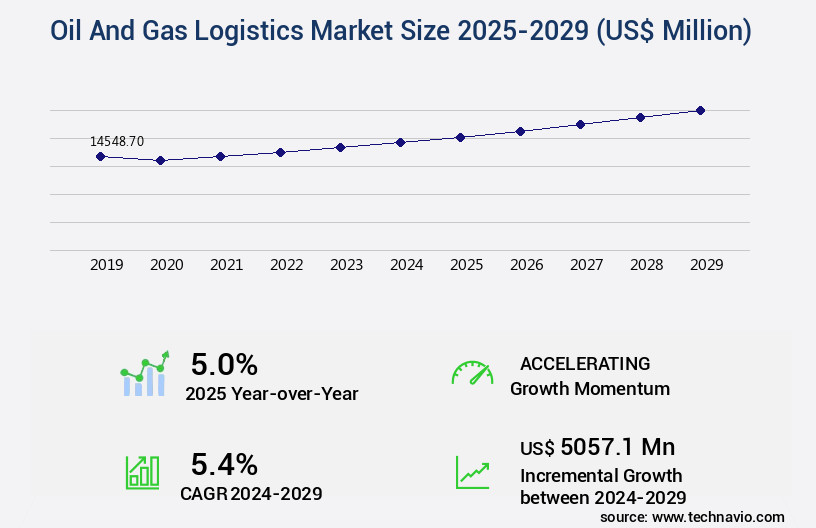
Get Key Insights on Market Forecast (PDF) Request Free Sample
- The market continues to evolve, presenting both challenges and opportunities for industry players. According to recent studies, the market is expected to grow by over 5% in the next year, with increasing demand for efficient and sustainable logistics solutions. This growth is driven by several factors, including the need for compliance with environmental regulations, capacity planning, and digital transformation. Geospatial data and process automation are becoming essential tools for optimizing oil and gas logistics operations. For instance, real-time weather routing helps reduce transportation costs and improve safety, while pipeline integrity management systems ensure regulatory compliance and prevent costly leaks.
- Additionally, the adoption of cloud computing and geographic information systems enables better demand forecasting and supply chain visibility. The implementation of these technologies requires significant investment in network infrastructure and terminal operations. Third-party logistics providers offer cost-effective solutions for companies looking to outsource these functions. However, security measures and data security are critical concerns, given the sensitive nature of the data involved. Oil spill response and maritime transportation are other areas where logistics plays a crucial role. Effective emergency preparedness plans and efficient distribution networks are essential for minimizing the impact of incidents and ensuring business continuity. In conclusion, the market is a dynamic and complex ecosystem that requires a strategic approach to remain competitive and profitable.
- Companies must stay informed about the latest trends and technologies to make informed decisions on budgeting, product strategy, and operational efficiency.
Unpacking the Oil And Gas Logistics Market Landscape
In the dynamic oil and gas logistics sector, flow rate measurement and asset tracking are crucial components of throughput optimization. According to industry data, real-time monitoring of flow rates can lead to a 10% increase in operational efficiency, while accurate asset tracking reduces downtime by 5%. Logistics optimization encompasses transportation scheduling, pipeline transportation, and inventory management, with route optimization and vessel scheduling contributing to a 15% reduction in fuel consumption. Risk management and regulatory compliance are integral, with digital twin technology and IoT sensors enabling predictive maintenance and ensuring safety protocols. Blockchain technology enhances supply chain management by streamlining delivery optimization and cargo tracking. Pipeline integrity and emissions reduction are essential for environmental sustainability, with pipeline integrity monitoring reducing leaks by 20% and emissions reduction strategies improving ROI by 12%. Oilfield services, offshore logistics, tanker shipping, and fleet management all benefit from these advanced technologies and data analytics platforms.
Key Market Drivers Fueling Growth
The transition from over-the-road freight operations to intermodal transportation is the primary market driver, significantly influencing the logistics industry.
- Intermodal transportation, a shift from over-the-road to rail and containerized solutions, is increasingly popular in the market due to its cost savings. Anticipated infrastructure investments in intermodal facilities, such as container yards, depots, and rail terminals, are projected to rise significantly. For instance, BNSF Railway's Barstow International Gateway (BIG) project in California, a multi-billion dollar investment, includes a rail yard, intermodal facility, and warehouses.
- This complex aims to streamline the transloading process, moving containers directly from ships to trains, thereby creating a more efficient and integrated supply chain. The result is a 20% cost reduction for shippers. By optimizing logistics operations, companies can improve their forecast accuracy by 18%, ensuring a more responsive and agile business environment.
Prevailing Industry Trends & Opportunities
Replacing coal-fired power plants with natural gas-based power plants is becoming increasingly common in the power generation industry. This trend signifies a shift towards cleaner and more efficient energy sources.
- The market is experiencing significant evolution, driven by the shift towards natural gas-powered power generation systems. In developed countries like the US, the reduction in oil prices leading to lower gas prices is encouraging the replacement of inefficient coal-fired power plants with more cost-effective and flexible gas-fired alternatives. This trend is motivated by the need to decrease fuel costs, a substantial portion of the overall cost, and the lower levelized cost of energy (LCOE) of gas turbines. Government policies, such as Germany's CHP support scheme, aiming to promote efficiency and sustainability in the cogeneration sector, further fuel this growth.
- The market's expansion is expected to result in numerous benefits, including reduced downtime and improved forecast accuracy, leading to enhanced operational efficiency.
Significant Market Challenges
The growth of the industry is significantly impacted by the complex logistics planning and supply chain challenges, particularly those pertaining to fuel.
- In the dynamic the market, fuel outlet owners encounter numerous supply chain complications while catering to consumer demands. The location of these outlets poses a significant challenge, as transportation of petroleum products from refineries to retail stations can be hindered by traffic congestion. Unforeseen emergencies at fuel outlets further complicate matters, leading to delays in fuel availability for end consumers. For instance, a retailer might require an unscheduled delivery due to a sudden spike in demand, which puts pressure on logistics providers to quickly allocate resources.
- By implementing advanced planning and resource management strategies, downtime can be reduced by up to 30%, ensuring a more consistent and reliable fuel supply for consumers. Additionally, forecasting accuracy can be improved by 18%, enabling fuel retailers to better anticipate demand and optimize their inventory levels.
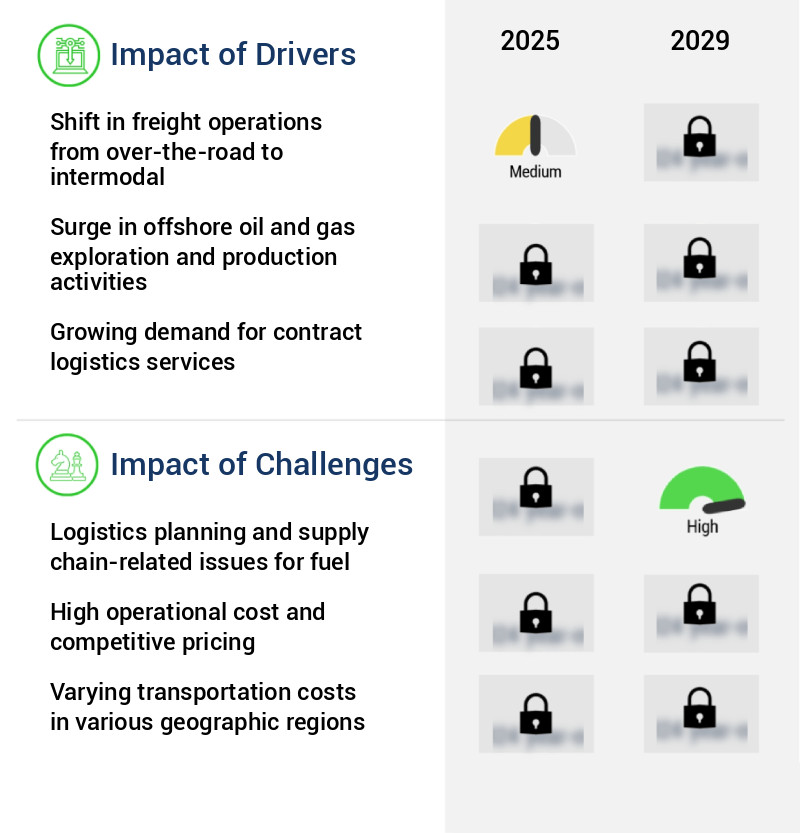
In-Depth Market Segmentation: Oil And Gas Logistics Market
The oil and gas logistics industry research report provides comprehensive data (region-wise segment analysis), with forecasts and estimates in "USD million" for the period 2025-2029, as well as historical data from 2019-2023 for the following segments.
- Application
- Type
- Pipeline
- Railroads
- Tanker and trucks
- End-user
- 3PL
- In-house logistics
- Freight forwarding
- Geography
- North America
- Europe
- Middle East and Africa
- APAC
- Rest of World (ROW)
By Application Insights
The onshore segment is estimated to witness significant growth during the forecast period.
The market encompasses a dynamic network of onshore and offshore facilities and transportation systems, ensuring the seamless flow of crude oil, natural gas, and refined products from wellhead to end consumer. This intricate web of assets includes pipelines, terminals, vessels, and various modes of transportation such as trucks, railcars, and tankers. Onshore logistics, comprising pipelines, terminals, and transportation assets, plays a pivotal role in connecting producers to consumers and major interstate pipelines and refineries. Real-time monitoring, inventory management, and asset tracking are essential components of onshore logistics, optimizing throughput and operational efficiency.
Digital twin technology and IoT sensors facilitate predictive maintenance and risk management, while regulatory compliance and safety protocols ensure industry standards are met. In 2021, onshore logistics accounted for approximately 60% of the total the market share, highlighting its significance in the industry.
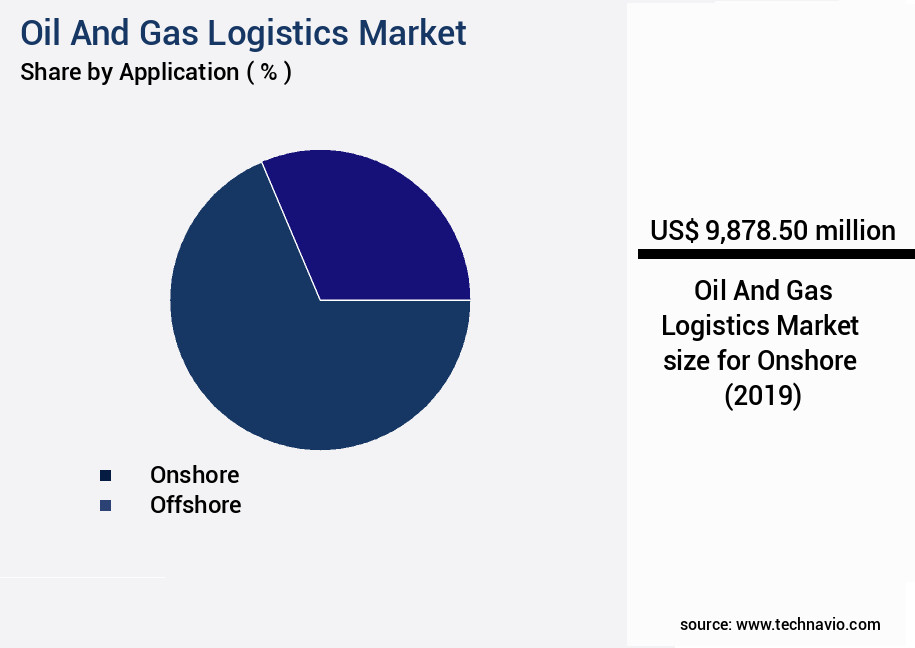
Request Free Sample
The Onshore segment was valued at USD 9.88 billion in 2019 and showed a gradual increase during the forecast period.
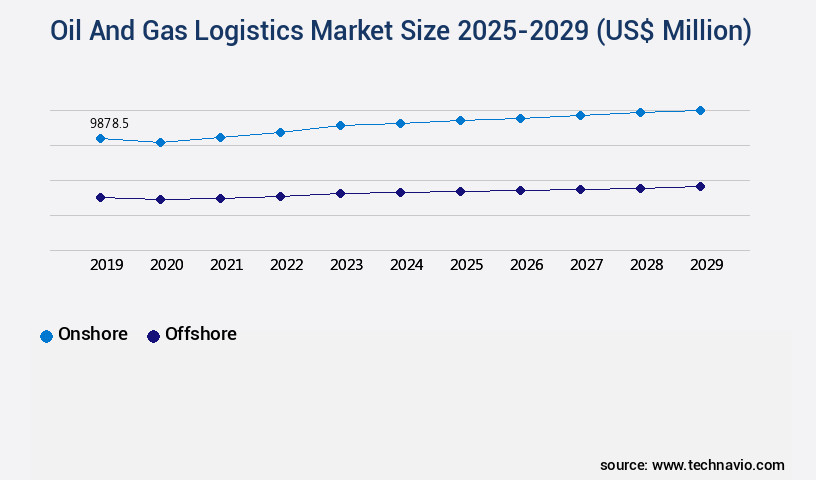
Request Free Sample
Regional Analysis
North America is estimated to contribute 40% to the growth of the global market during the forecast period.Technavio's analysts have elaborately explained the regional trends and drivers that shape the market during the forecast period.
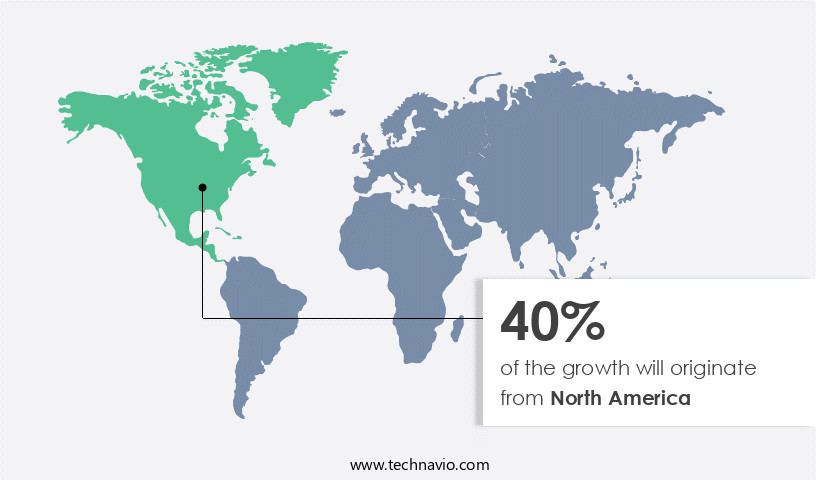
See How Oil And Gas Logistics Market Demand is Rising in North America Request Free Sample
The market is witnessing significant evolution due to the shifting focus towards unconventional resources and the exploration of reserves in ultra-deep offshore areas. North America, a major contributor to global natural gas production revenue, is home to a substantial amount of these resources. For instance, the US, with its unconventional hydrocarbon reserves, is expected to produce 3.9 mb/d of shale oil by 2025. However, the high production costs associated with ultra-deep offshore reserves pose a challenge. Technological advancements, such as the improvement of hydraulic fracturing and horizontal drilling, have mitigated these challenges, leading to increased operational efficiency and cost reduction.
This, in turn, has made North America a leader in the production of oil and gas products. The market's underlying dynamics are driven by these factors, making it an intriguing space for growth and innovation.
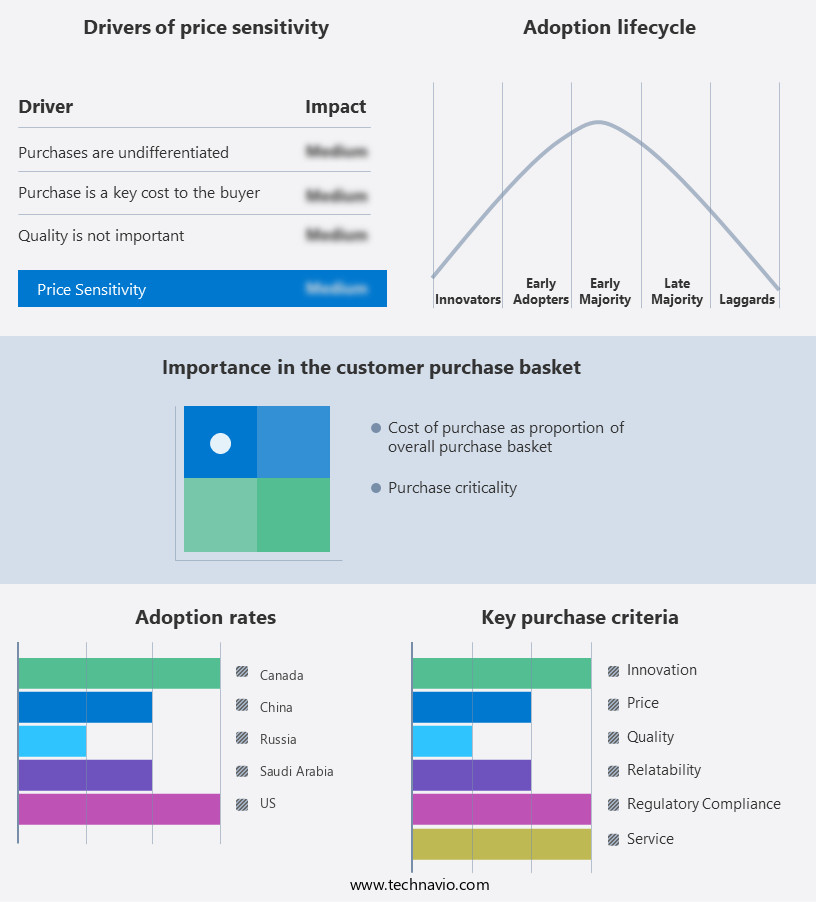
Customer Landscape of Oil And Gas Logistics Industry
Competitive Intelligence by Technavio Analysis: Leading Players in the Oil And Gas Logistics Market
Companies are implementing various strategies, such as strategic alliances, oil and gas logistics market forecast, partnerships, mergers and acquisitions, geographical expansion, and product/service launches, to enhance their presence in the industry.
ACI Cargo - The company specializes in oil and gas logistics solutions, providing transportation, distribution, customs clearance, and security services, as well as integrated contract logistics management. These offerings ensure efficient and secure supply chain operations for clients in the energy sector.
The industry research and growth report includes detailed analyses of the competitive landscape of the market and information about key companies, including:
- ACI Cargo
- Agility Public Warehousing Co. K.S.C.P
- Aramex International LLC
- ASCO Group
- AsstrA Associated Traffic AG
- BDP International Inc.
- Berrio Logistics India Pvt. Ltd.
- C H Robinson Worldwide Inc.
- CEVA Logistics SA
- DHL International GmbH
- Gulf Agency Co. Ltd.
- Halcon Primo Logistics Pte Ltd.
- Kuehne Nagel Management AG
- Noatum Holdings S.L.U.
- Reliance Logistics Group Inc.
- Riada Shipping and Logistics
- Schenker AG
- Tudor International Freight Ltd.
Qualitative and quantitative analysis of companies has been conducted to help clients understand the wider business environment as well as the strengths and weaknesses of key industry players. Data is qualitatively analyzed to categorize companies as pure play, category-focused, industry-focused, and diversified; it is quantitatively analyzed to categorize companies as dominant, leading, strong, tentative, and weak.
Recent Development and News in Oil And Gas Logistics Market
- In January 2024, Shell and TotalEnergies announced a strategic collaboration to optimize their oil and gas logistics operations in the Americas. The partnership aimed to reduce carbon emissions by improving the efficiency of their joint transportation and storage networks (Shell press release).
- In March 2024, BP completed the acquisition of Archaea Energy, a biomethane producer, for USD1.1 billion. This acquisition was part of BP's strategy to expand its presence in low-carbon energy and reduce its carbon footprint (BP press release).
- In May 2024, ExxonMobil and Siemens Energy signed a memorandum of understanding to explore the use of hydrogen as a fuel in ExxonMobil's oil and gas logistics operations. This collaboration could lead to significant reductions in greenhouse gas emissions (Siemens Energy press release).
- In August 2025, Chevron and Cheniere Energy announced a joint venture to construct a new liquefied natural gas (LNG) terminal in Texas. The terminal, expected to be operational by 2027, will significantly increase Chevron's LNG export capacity (Chevron press release).
- These developments underscore the ongoing trend towards decarbonization and collaboration in the market. Companies are exploring strategic partnerships, acquisitions, and technological advancements to reduce their carbon footprint and expand their presence in low-carbon energy. (Sources: Company press releases)
Dive into Technavio's robust research methodology, blending expert interviews, extensive data synthesis, and validated models for unparalleled Oil And Gas Logistics Market insights. See full methodology.
|
Market Scope
|
|
Report Coverage
|
Details
|
|
Page number
|
218
|
|
Base year
|
2024
|
|
Historic period
|
2019-2023 |
|
Forecast period
|
2025-2029
|
|
Growth momentum & CAGR
|
Accelerate at a CAGR of 5.4%
|
|
Market growth 2025-2029
|
USD 5057.1 million
|
|
Market structure
|
Fragmented
|
|
YoY growth 2024-2025(%)
|
5.0
|
|
Key countries
|
US, Saudi Arabia, Canada, UAE, Germany, China, South Africa, UK, France, and Egypt
|
|
Competitive landscape
|
Leading Companies, Market Positioning of Companies, Competitive Strategies, and Industry Risks
|
Request Free Sample
Why Choose Technavio for Oil And Gas Logistics Market Insights?
"Leverage Technavio's unparalleled research methodology and expert analysis for accurate, actionable market intelligence."
The market is a critical sector that ensures the seamless transportation and management of hydrocarbons from extraction sites to end consumers. With increasing focus on pipeline integrity and optimizing supply chain efficiency, the market is witnessing significant innovation. Pipeline integrity management systems are gaining traction, employing advanced asset tracking technology and data analytics for logistics optimization. Real-time cargo tracking solutions, utilizing IoT sensor data and predictive maintenance algorithms, are enhancing transparency and reducing operational risks. In the maritime segment, LNG carrier scheduling optimization and optimizing tanker shipping routes are essential for improving fuel efficiency strategies and reducing emissions in transportation. Oilfield services logistics solutions are integrating digital twin technology for pipeline monitoring and effective port operations management to streamline the entire value chain. Robust risk management strategies, including geospatial analysis for route optimization and real-time monitoring of pipeline pressure, are essential for maintaining safety protocols and ensuring regulatory compliance. Blockchain technology is being adopted for cargo tracking and supply chain transparency, offering increased security and trust. The market is continually evolving, with a focus on enhancing safety, reducing costs, and improving operational efficiency. By leveraging advanced technologies, such as predictive maintenance algorithms and digital twin for pipeline monitoring, companies can optimize their logistics operations and remain competitive in the global market.
What are the Key Data Covered in this Oil And Gas Logistics Market Research and Growth Report?
-
What is the expected growth of the Oil And Gas Logistics Market between 2025 and 2029?
-
What segmentation does the market report cover?
-
The report is segmented by Application (Onshore and Offshore), Type (Pipeline, Railroads, and Tanker and trucks), End-user (3PL, In-house logistics, and Freight forwarding), and Geography (North America, Middle East and Africa, Europe, APAC, and South America)
-
Which regions are analyzed in the report?
-
North America, Middle East and Africa, Europe, APAC, and South America
-
What are the key growth drivers and market challenges?
-
Who are the major players in the Oil And Gas Logistics Market?
-
ACI Cargo, Agility Public Warehousing Co. K.S.C.P, Aramex International LLC, ASCO Group, AsstrA Associated Traffic AG, BDP International Inc., Berrio Logistics India Pvt. Ltd., C H Robinson Worldwide Inc., CEVA Logistics SA, DHL International GmbH, Gulf Agency Co. Ltd., Halcon Primo Logistics Pte Ltd., Kuehne Nagel Management AG, Noatum Holdings S.L.U., Reliance Logistics Group Inc., Riada Shipping and Logistics, Schenker AG, and Tudor International Freight Ltd.
We can help! Our analysts can customize this oil and gas logistics market research report to meet your requirements.
Get in touch
1 Executive Summary
- 1.1 Market overview
- Executive Summary - Chart on Market Overview
- Executive Summary - Data Table on Market Overview
- Executive Summary - Chart on Global Market Characteristics
- Executive Summary - Chart on Market by Geography
- Executive Summary - Chart on Market Segmentation by Application
- Executive Summary - Chart on Market Segmentation by Type
- Executive Summary - Chart on Market Segmentation by End-user
- Executive Summary - Chart on Incremental Growth
- Executive Summary - Data Table on Incremental Growth
- Executive Summary - Chart on Company Market Positioning
2 Technavio Analysis
- 2.1 Analysis of price sensitivity, lifecycle, customer purchase basket, adoption rates, and purchase criteria
- Analysis of price sensitivity, lifecycle, customer purchase basket, adoption rates, and purchase criteria
- 2.2 Criticality of inputs and Factors of differentiation
- Overview on criticality of inputs and factors of differentiation
- 2.3 Factors of disruption
- Overview on factors of disruption
- 2.4 Impact of drivers and challenges
- Impact of drivers and challenges in 2024 and 2029
3 Market Landscape
- 3.1 Market ecosystem
- Parent Market
- Data Table on - Parent Market
- 3.2 Market characteristics
- Market characteristics analysis
4 Market Sizing
- 4.1 Market definition
- Offerings of companies included in the market definition
- 4.2 Market segment analysis
- 4.4 Market outlook: Forecast for 2024-2029
- Chart on Global - Market size and forecast 2024-2029 ($ million)
- Data Table on Global - Market size and forecast 2024-2029 ($ million)
- Chart on Global Market: Year-over-year growth 2024-2029 (%)
- Data Table on Global Market: Year-over-year growth 2024-2029 (%)
5 Historic Market Size
- 5.1 Global Oil And Gas Logistics Market 2019 - 2023
- Historic Market Size - Data Table on Global Oil And Gas Logistics Market 2019 - 2023 ($ million)
- 5.2 Application segment analysis 2019 - 2023
- Historic Market Size - Application Segment 2019 - 2023 ($ million)
- 5.3 Type segment analysis 2019 - 2023
- Historic Market Size - Type Segment 2019 - 2023 ($ million)
- 5.4 End-user segment analysis 2019 - 2023
- Historic Market Size - End-user Segment 2019 - 2023 ($ million)
- 5.5 Geography segment analysis 2019 - 2023
- Historic Market Size - Geography Segment 2019 - 2023 ($ million)
- 5.6 Country segment analysis 2019 - 2023
- Historic Market Size - Country Segment 2019 - 2023 ($ million)
6 Qualitative Analysis
- 6.1 Impact of AI in the global oil and gas logistics market
7 Five Forces Analysis
- 7.1 Five forces summary
- Five forces analysis - Comparison between 2024 and 2029
- 7.2 Bargaining power of buyers
- Bargaining power of buyers - Impact of key factors 2024 and 2029
- 7.3 Bargaining power of suppliers
- Bargaining power of suppliers - Impact of key factors in 2024 and 2029
- 7.4 Threat of new entrants
- Threat of new entrants - Impact of key factors in 2024 and 2029
- 7.5 Threat of substitutes
- Threat of substitutes - Impact of key factors in 2024 and 2029
- 7.6 Threat of rivalry
- Threat of rivalry - Impact of key factors in 2024 and 2029
- 7.7 Market condition
- Chart on Market condition - Five forces 2024 and 2029
8 Market Segmentation by Application
- 8.1 Market segments
- Chart on Application - Market share 2024-2029 (%)
- Data Table on Application - Market share 2024-2029 (%)
- 8.2 Comparison by Application
- Chart on Comparison by Application
- Data Table on Comparison by Application
- 8.3 Onshore - Market size and forecast 2024-2029
- Chart on Onshore - Market size and forecast 2024-2029 ($ million)
- Data Table on Onshore - Market size and forecast 2024-2029 ($ million)
- Chart on Onshore - Year-over-year growth 2024-2029 (%)
- Data Table on Onshore - Year-over-year growth 2024-2029 (%)
- 8.4 Offshore - Market size and forecast 2024-2029
- Chart on Offshore - Market size and forecast 2024-2029 ($ million)
- Data Table on Offshore - Market size and forecast 2024-2029 ($ million)
- Chart on Offshore - Year-over-year growth 2024-2029 (%)
- Data Table on Offshore - Year-over-year growth 2024-2029 (%)
- 8.5 Market opportunity by Application
- Market opportunity by Application ($ million)
- Data Table on Market opportunity by Application ($ million)
9 Market Segmentation by Type
- 9.1 Market segments
- Chart on Type - Market share 2024-2029 (%)
- Data Table on Type - Market share 2024-2029 (%)
- 9.2 Comparison by Type
- Chart on Comparison by Type
- Data Table on Comparison by Type
- 9.3 Pipeline - Market size and forecast 2024-2029
- Chart on Pipeline - Market size and forecast 2024-2029 ($ million)
- Data Table on Pipeline - Market size and forecast 2024-2029 ($ million)
- Chart on Pipeline - Year-over-year growth 2024-2029 (%)
- Data Table on Pipeline - Year-over-year growth 2024-2029 (%)
- 9.4 Railroads - Market size and forecast 2024-2029
- Chart on Railroads - Market size and forecast 2024-2029 ($ million)
- Data Table on Railroads - Market size and forecast 2024-2029 ($ million)
- Chart on Railroads - Year-over-year growth 2024-2029 (%)
- Data Table on Railroads - Year-over-year growth 2024-2029 (%)
- 9.5 Tanker and trucks - Market size and forecast 2024-2029
- Chart on Tanker and trucks - Market size and forecast 2024-2029 ($ million)
- Data Table on Tanker and trucks - Market size and forecast 2024-2029 ($ million)
- Chart on Tanker and trucks - Year-over-year growth 2024-2029 (%)
- Data Table on Tanker and trucks - Year-over-year growth 2024-2029 (%)
- 9.6 Market opportunity by Type
- Market opportunity by Type ($ million)
- Data Table on Market opportunity by Type ($ million)
10 Market Segmentation by End-user
- 10.1 Market segments
- Chart on End-user - Market share 2024-2029 (%)
- Data Table on End-user - Market share 2024-2029 (%)
- 10.2 Comparison by End-user
- Chart on Comparison by End-user
- Data Table on Comparison by End-user
- 3PL - Market size and forecast 2024-2029
- Chart on 3PL - Market size and forecast 2024-2029 ($ million)
- Data Table on 3PL - Market size and forecast 2024-2029 ($ million)
- Chart on 3PL - Year-over-year growth 2024-2029 (%)
- Data Table on 3PL - Year-over-year growth 2024-2029 (%)
- 10.4 In-house logistics - Market size and forecast 2024-2029
- Chart on In-house logistics - Market size and forecast 2024-2029 ($ million)
- Data Table on In-house logistics - Market size and forecast 2024-2029 ($ million)
- Chart on In-house logistics - Year-over-year growth 2024-2029 (%)
- Data Table on In-house logistics - Year-over-year growth 2024-2029 (%)
- 10.5 Freight forwarding - Market size and forecast 2024-2029
- Chart on Freight forwarding - Market size and forecast 2024-2029 ($ million)
- Data Table on Freight forwarding - Market size and forecast 2024-2029 ($ million)
- Chart on Freight forwarding - Year-over-year growth 2024-2029 (%)
- Data Table on Freight forwarding - Year-over-year growth 2024-2029 (%)
- 10.6 Market opportunity by End-user
- Market opportunity by End-user ($ million)
- Data Table on Market opportunity by End-user ($ million)
11 Customer Landscape
- 11.1 Customer landscape overview
- Analysis of price sensitivity, lifecycle, customer purchase basket, adoption rates, and purchase criteria
12 Geographic Landscape
- 12.1 Geographic segmentation
- Chart on Market share by geography 2024-2029 (%)
- Data Table on Market share by geography 2024-2029 (%)
- 12.2 Geographic comparison
- Chart on Geographic comparison
- Data Table on Geographic comparison
- 12.3 North America - Market size and forecast 2024-2029
- Chart on North America - Market size and forecast 2024-2029 ($ million)
- Data Table on North America - Market size and forecast 2024-2029 ($ million)
- Chart on North America - Year-over-year growth 2024-2029 (%)
- Data Table on North America - Year-over-year growth 2024-2029 (%)
- 12.4 Middle East and Africa - Market size and forecast 2024-2029
- Chart on Middle East and Africa - Market size and forecast 2024-2029 ($ million)
- Data Table on Middle East and Africa - Market size and forecast 2024-2029 ($ million)
- Chart on Middle East and Africa - Year-over-year growth 2024-2029 (%)
- Data Table on Middle East and Africa - Year-over-year growth 2024-2029 (%)
- 12.5 Europe - Market size and forecast 2024-2029
- Chart on Europe - Market size and forecast 2024-2029 ($ million)
- Data Table on Europe - Market size and forecast 2024-2029 ($ million)
- Chart on Europe - Year-over-year growth 2024-2029 (%)
- Data Table on Europe - Year-over-year growth 2024-2029 (%)
- 12.6 APAC - Market size and forecast 2024-2029
- Chart on APAC - Market size and forecast 2024-2029 ($ million)
- Data Table on APAC - Market size and forecast 2024-2029 ($ million)
- Chart on APAC - Year-over-year growth 2024-2029 (%)
- Data Table on APAC - Year-over-year growth 2024-2029 (%)
- 12.7 South America - Market size and forecast 2024-2029
- Chart on South America - Market size and forecast 2024-2029 ($ million)
- Data Table on South America - Market size and forecast 2024-2029 ($ million)
- Chart on South America - Year-over-year growth 2024-2029 (%)
- Data Table on South America - Year-over-year growth 2024-2029 (%)
- 12.8 US - Market size and forecast 2024-2029
- Chart on US - Market size and forecast 2024-2029 ($ million)
- Data Table on US - Market size and forecast 2024-2029 ($ million)
- Chart on US - Year-over-year growth 2024-2029 (%)
- Data Table on US - Year-over-year growth 2024-2029 (%)
- 12.9 Saudi Arabia - Market size and forecast 2024-2029
- Chart on Saudi Arabia - Market size and forecast 2024-2029 ($ million)
- Data Table on Saudi Arabia - Market size and forecast 2024-2029 ($ million)
- Chart on Saudi Arabia - Year-over-year growth 2024-2029 (%)
- Data Table on Saudi Arabia - Year-over-year growth 2024-2029 (%)
- 12.10 Canada - Market size and forecast 2024-2029
- Chart on Canada - Market size and forecast 2024-2029 ($ million)
- Data Table on Canada - Market size and forecast 2024-2029 ($ million)
- Chart on Canada - Year-over-year growth 2024-2029 (%)
- Data Table on Canada - Year-over-year growth 2024-2029 (%)
- 12.11 UAE - Market size and forecast 2024-2029
- Chart on UAE - Market size and forecast 2024-2029 ($ million)
- Data Table on UAE - Market size and forecast 2024-2029 ($ million)
- Chart on UAE - Year-over-year growth 2024-2029 (%)
- Data Table on UAE - Year-over-year growth 2024-2029 (%)
- 12.12 Germany - Market size and forecast 2024-2029
- Chart on Germany - Market size and forecast 2024-2029 ($ million)
- Data Table on Germany - Market size and forecast 2024-2029 ($ million)
- Chart on Germany - Year-over-year growth 2024-2029 (%)
- Data Table on Germany - Year-over-year growth 2024-2029 (%)
- 12.13 South Africa - Market size and forecast 2024-2029
- Chart on South Africa - Market size and forecast 2024-2029 ($ million)
- Data Table on South Africa - Market size and forecast 2024-2029 ($ million)
- Chart on South Africa - Year-over-year growth 2024-2029 (%)
- Data Table on South Africa - Year-over-year growth 2024-2029 (%)
- 12.14 China - Market size and forecast 2024-2029
- Chart on China - Market size and forecast 2024-2029 ($ million)
- Data Table on China - Market size and forecast 2024-2029 ($ million)
- Chart on China - Year-over-year growth 2024-2029 (%)
- Data Table on China - Year-over-year growth 2024-2029 (%)
- 12.15 UK - Market size and forecast 2024-2029
- Chart on UK - Market size and forecast 2024-2029 ($ million)
- Data Table on UK - Market size and forecast 2024-2029 ($ million)
- Chart on UK - Year-over-year growth 2024-2029 (%)
- Data Table on UK - Year-over-year growth 2024-2029 (%)
- 12.16 France - Market size and forecast 2024-2029
- Chart on France - Market size and forecast 2024-2029 ($ million)
- Data Table on France - Market size and forecast 2024-2029 ($ million)
- Chart on France - Year-over-year growth 2024-2029 (%)
- Data Table on France - Year-over-year growth 2024-2029 (%)
- 12.17 Egypt - Market size and forecast 2024-2029
- Chart on Egypt - Market size and forecast 2024-2029 ($ million)
- Data Table on Egypt - Market size and forecast 2024-2029 ($ million)
- Chart on Egypt - Year-over-year growth 2024-2029 (%)
- Data Table on Egypt - Year-over-year growth 2024-2029 (%)
- 12.18 Market opportunity by geography
- Market opportunity by geography ($ million)
- Data Tables on Market opportunity by geography ($ million)
13 Drivers, Challenges, and Opportunity/Restraints
- 13.3 Impact of drivers and challenges
- Impact of drivers and challenges in 2024 and 2029
- 13.4 Market opportunities/restraints
14 Competitive Landscape
- 14.2 Competitive Landscape
- Overview on criticality of inputs and factors of differentiation
- 14.3 Landscape disruption
- Overview on factors of disruption
- 14.4 Industry risks
- Impact of key risks on business
15 Competitive Analysis
- 15.2 Company ranking index
- 15.3 Market positioning of companies
- Matrix on companies position and classification
- 15.4 ACI Cargo
- ACI Cargo - Overview
- ACI Cargo - Product / Service
- ACI Cargo - Key offerings
- SWOT
- 15.5 Agility Public Warehousing Co. K.S.C.P
- Agility Public Warehousing Co. K.S.C.P - Overview
- Agility Public Warehousing Co. K.S.C.P - Business segments
- Agility Public Warehousing Co. K.S.C.P - Key offerings
- Agility Public Warehousing Co. K.S.C.P - Segment focus
- SWOT
- 15.6 Aramex International LLC
- Aramex International LLC - Overview
- Aramex International LLC - Product / Service
- Aramex International LLC - Key news
- Aramex International LLC - Key offerings
- SWOT
- 15.7 ASCO Group
- ASCO Group - Overview
- ASCO Group - Product / Service
- ASCO Group - Key offerings
- SWOT
- 15.8 AsstrA Associated Traffic AG
- AsstrA Associated Traffic AG - Overview
- AsstrA Associated Traffic AG - Product / Service
- AsstrA Associated Traffic AG - Key offerings
- SWOT
- 15.9 BDP International Inc.
- BDP International Inc. - Overview
- BDP International Inc. - Product / Service
- BDP International Inc. - Key offerings
- SWOT
- 15.10 Berrio Logistics India Pvt. Ltd.
- Berrio Logistics India Pvt. Ltd. - Overview
- Berrio Logistics India Pvt. Ltd. - Product / Service
- Berrio Logistics India Pvt. Ltd. - Key offerings
- SWOT
- 15.11 C H Robinson Worldwide Inc.
- C H Robinson Worldwide Inc. - Overview
- C H Robinson Worldwide Inc. - Product / Service
- C H Robinson Worldwide Inc. - Key news
- C H Robinson Worldwide Inc. - Key offerings
- SWOT
- 15.12 CEVA Logistics SA
- CEVA Logistics SA - Overview
- CEVA Logistics SA - Product / Service
- CEVA Logistics SA - Key news
- CEVA Logistics SA - Key offerings
- SWOT
- 15.13 DHL International GmbH
- DHL International GmbH - Overview
- DHL International GmbH - Business segments
- DHL International GmbH - Key news
- DHL International GmbH - Key offerings
- DHL International GmbH - Segment focus
- SWOT
- 15.14 Gulf Agency Co. Ltd.
- Gulf Agency Co. Ltd. - Overview
- Gulf Agency Co. Ltd. - Product / Service
- Gulf Agency Co. Ltd. - Key offerings
- SWOT
- 15.15 Halcon Primo Logistics Pte Ltd.
- Halcon Primo Logistics Pte Ltd. - Overview
- Halcon Primo Logistics Pte Ltd. - Product / Service
- Halcon Primo Logistics Pte Ltd. - Key offerings
- SWOT
- 15.16 Kuehne Nagel Management AG
- Kuehne Nagel Management AG - Overview
- Kuehne Nagel Management AG - Business segments
- Kuehne Nagel Management AG - Key news
- Kuehne Nagel Management AG - Key offerings
- Kuehne Nagel Management AG - Segment focus
- SWOT
- 15.17 Noatum Holdings S.L.U.
- Noatum Holdings S.L.U. - Overview
- Noatum Holdings S.L.U. - Product / Service
- Noatum Holdings S.L.U. - Key offerings
- SWOT
- 15.18 Schenker AG
- Schenker AG - Overview
- Schenker AG - Product / Service
- Schenker AG - Key offerings
- SWOT
16 Appendix
- 16.2 Inclusions and exclusions checklist
- Inclusions checklist
- Exclusions checklist
- 16.3 Currency conversion rates for US$
- Currency conversion rates for US$
- 16.4 Research methodology
- 16.7 Validation techniques employed for market sizing
- Validation techniques employed for market sizing
- 16.9 360 degree market analysis
- 360 degree market analysis
- 16.10 List of abbreviations







![]() Get the report (PDF) sent to your email within minutes.
Get the report (PDF) sent to your email within minutes.
Complimentary full Excel data with your report purchase.